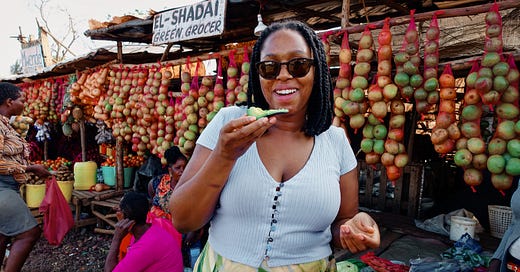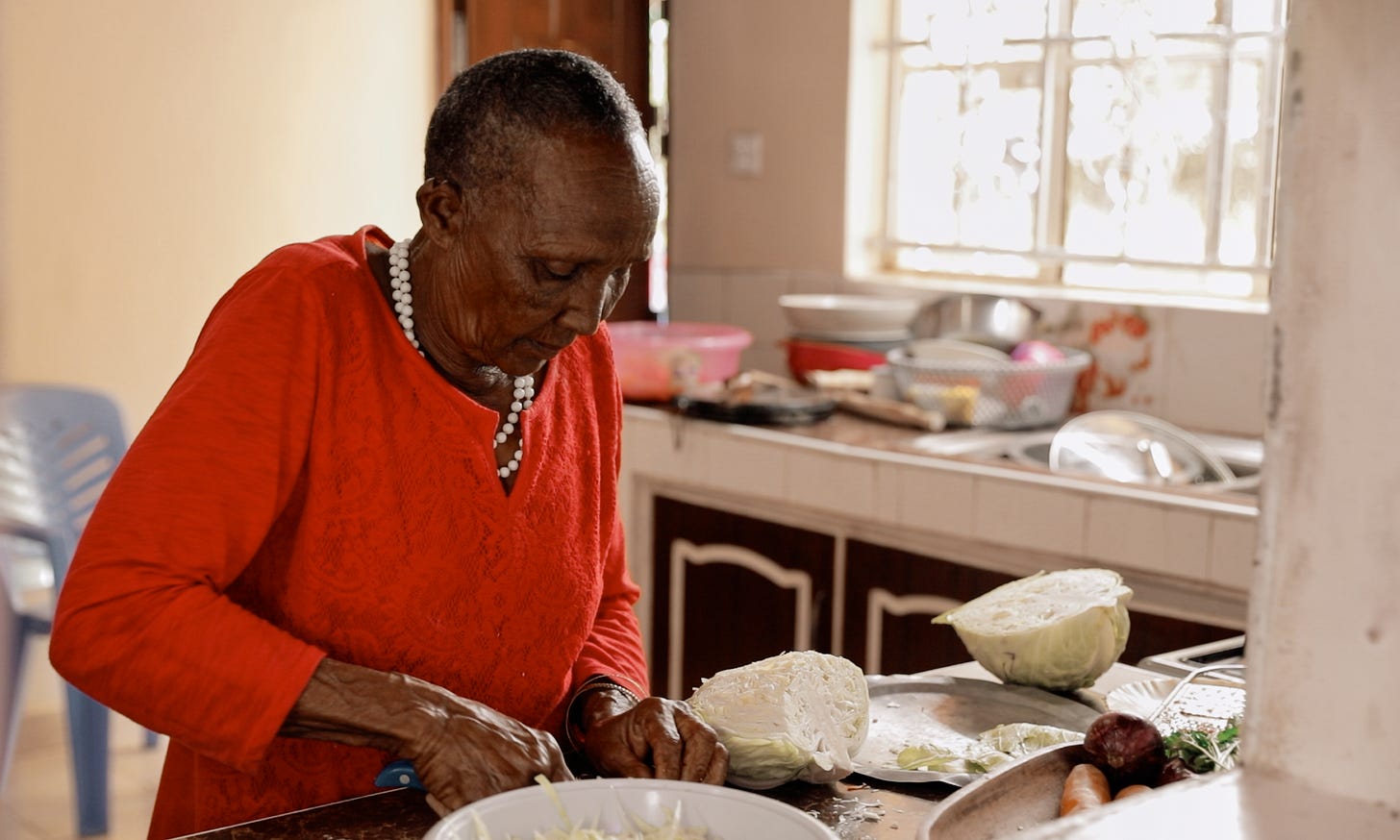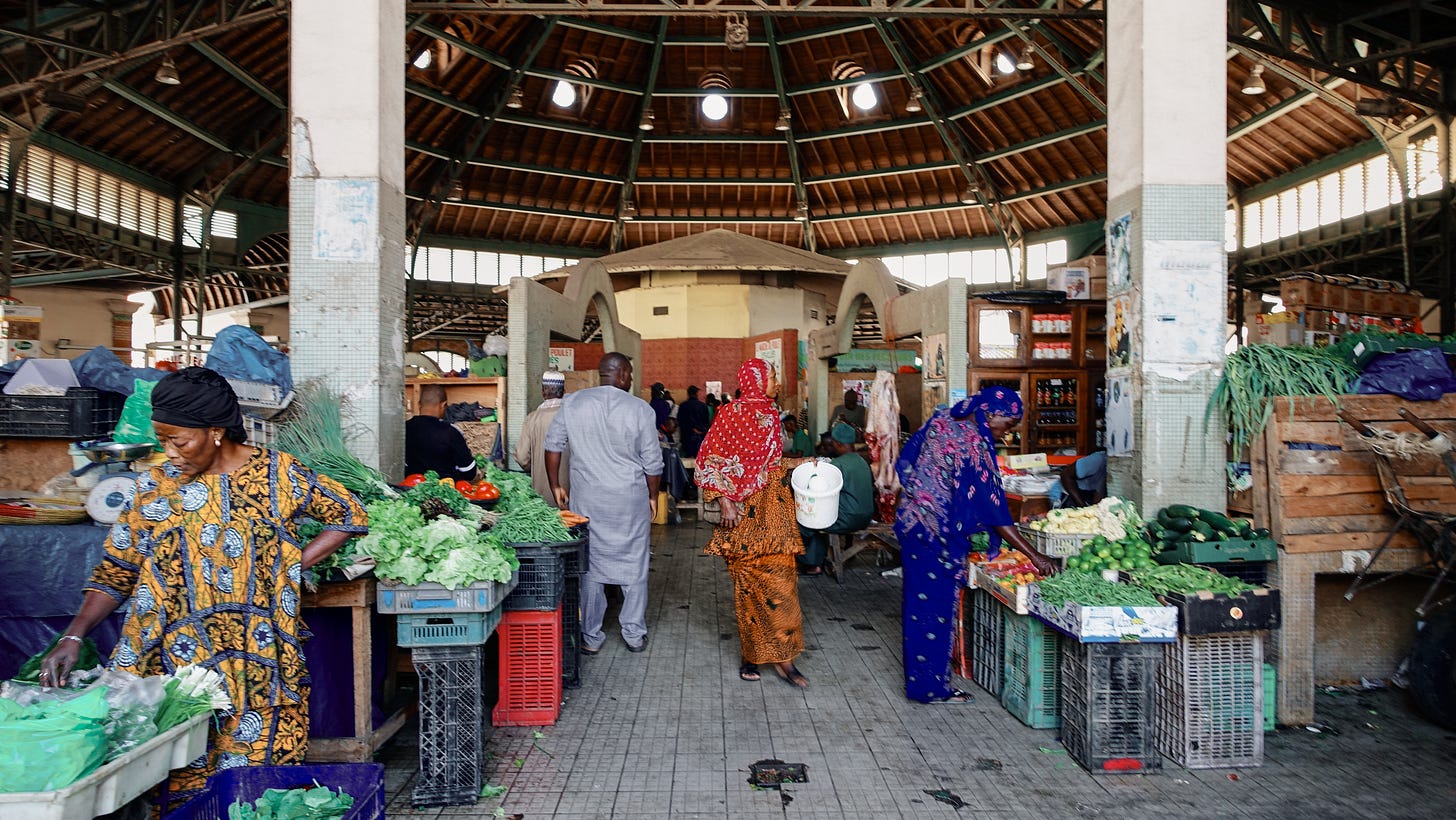002: Kiano Moju
On her new cookbook, "AfriCali" (plus a recipe!), and what people get wrong about African cuisines...
Who doesn’t like peeking inside someone’s kitchen and seeing the nooks, crannies and crumbs (I don’t judge) of what makes a person’s world go round for breakfast, lunch and dinner? This is Second Meal.
A note: I had every intention of putting Kiano’s favorite cooking utensils and ingredients in this newsletter, and highlighting her stunning sage green kitchen, but something felt off. Unless you are of the culture or have proactively done the research, the centralizing of African cuisines and foodways are too important of topics to be scanned and missed. We don’t see it nearly enough in food media, and when we do, it’s usually a checkbox to mark off. Done. Next year we’ll profile another African cuisine.
I think we can do better.
Kiano Moju is a raised in the Bay, Los Angeles-based cookbook author and the founder of Jikoni Recipe Archive, a nonprofit preserving and celebrating the culinary heritage of African cuisines and foodways throughout the diaspora. She is the author of the new cookbook, “AfriCali: Recipes from My Jikoni” which draws from her Kenyan and Nigerian heritage fused with the California cuisines she grew up eating. You may recognize Kiano from her work as a video producer for Buzzfeed’s Tasty during the height of the brand’s virality.
By the time I started working at Tasty, Kiano had moved on and created her own full-service production company, Jikoni Studios, which has produced cooking videos and commercials for Food Network, Fox Studios and the USDA. I met Kiano in 2019 when she asked if I wanted to speak on a panel about diversity in food media. I said “YES,” and Kiano and I have since bonded over the lack of inclusivity and representation in our line of work: from the gatekeepers at the tippity-top who hire talent and greenlight content, to the most-liked and shared stories that seldomly highlight underrepresented cultures and cuisines.
Kiano is doing the work to bring attention to cuisines that have been culturally misrepresented and historically shunned in traditional food media.
But I’ll let her tell you more about that.
Scroll down to find a special surprise from her cookbook, “AfriCali.”
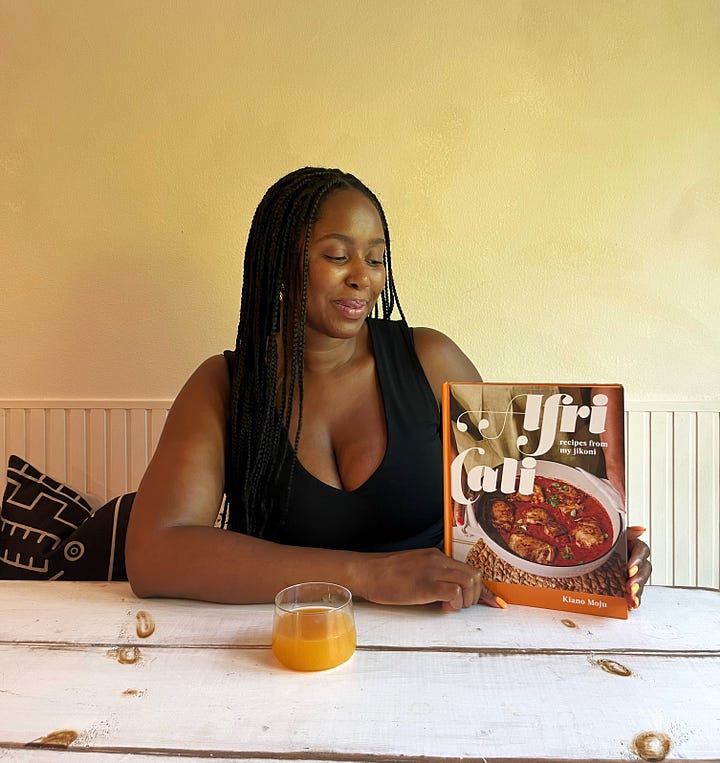
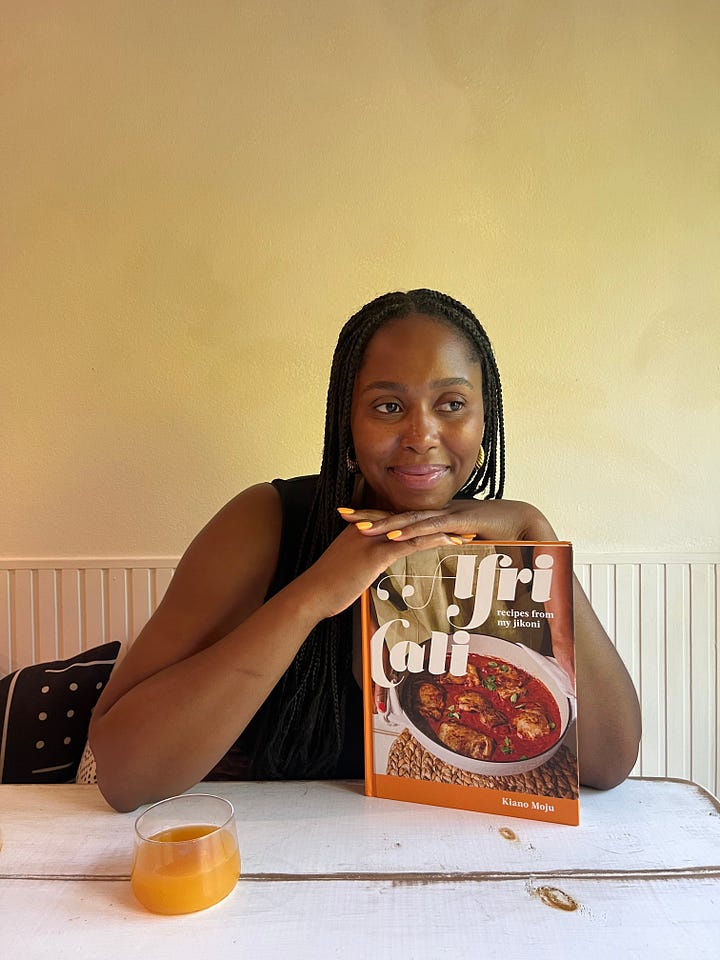
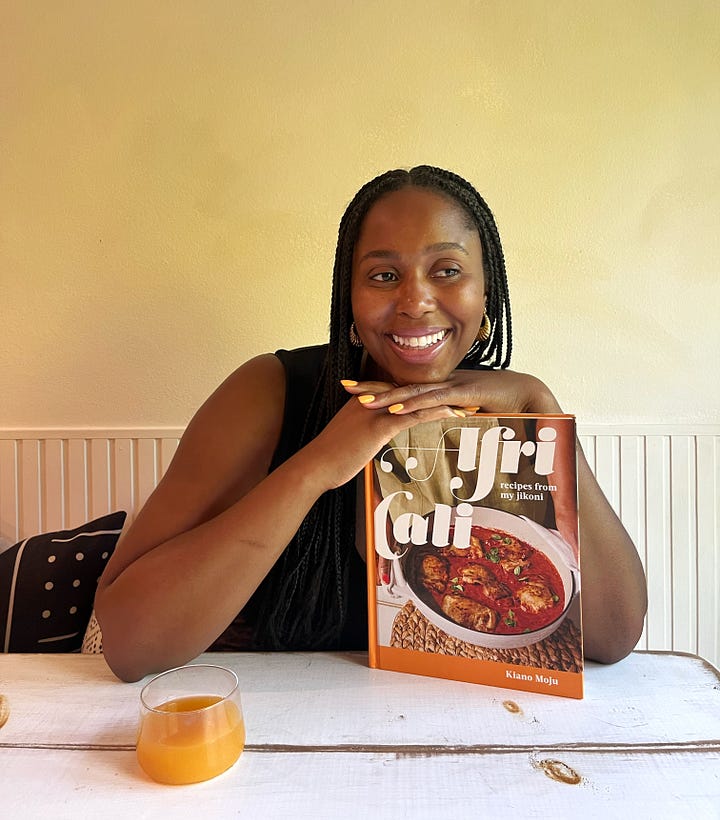
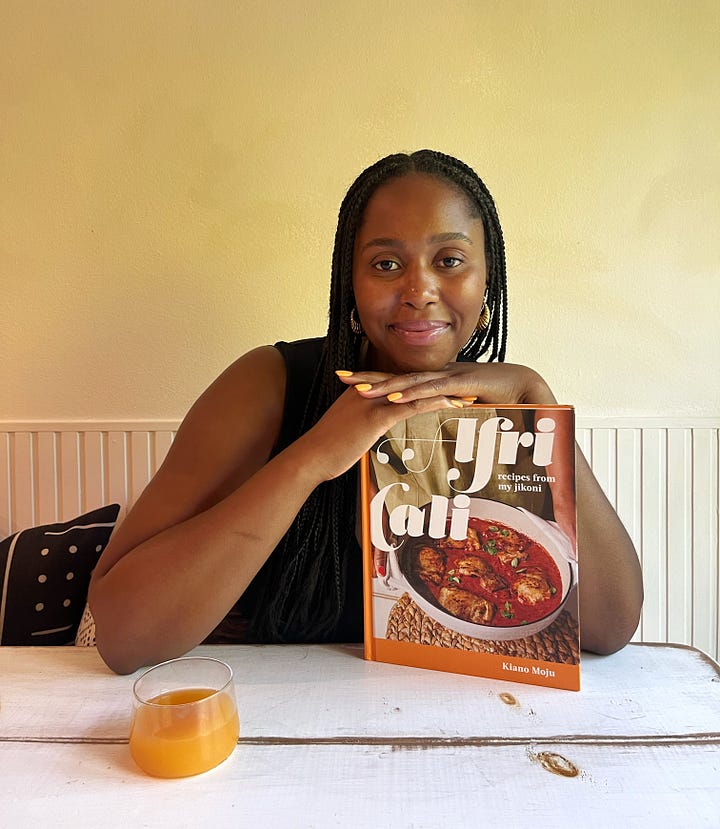
Let’s start with the easiest question (or maybe not). Who taught you how to cook?
A lot of people taught me how to cook. My mom cooked out of necessity, not out of joy. So when I was little, she would cook and put me on the counter, and I would watch and help. She would make chapati and give me a little piece of dough. I wanted my piece of dough to do everything her piece of dough did. If her dough got rolled, mine needed to get rolled. If her dough was in the pan, mine needed to be in the pan.
Finally, she said, “I can’t cook like this!” so she put me in a cooking camp when I was around six or seven. My mom also bought me a kid’s cookbook with recipes from around the world, which really meant North America and Europe. I ran through that book. The “Spain chapter” had me, and I was making paella as a kid.
Weekend mornings became my domain. Once my mom knew I had the skills and that I wouldn’t burn the house down or lose a limb, I was allowed in the kitchen to make breakfast, which is a pretty sweet deal if your kid can make you breakfast. In high school, I took culinary classes where I learned technical skills, like how to dice an onion, but before that, it was basically the school of aunties: a community of women teaching me how to make mostly Latin American, European and a few Asian dishes.
My grandmother taught me how to cook, and I know you have a story about your grandma in Kenya. What lessons did she teach you?
When I was seven, we spent every other summer in Kenya. My mom’s parents had a very traditional Maasai home. Maasai people are pastoralists, so livestock is the center of life. On the ranch, we had cows, goats and sheep. It was a farm. I learned a lot from my grandma and the other women from the community. My grandma is one of those people who believes, “Kids don’t need to cook,” so once again, I was the annoying child in the kitchen. In other households, I helped other women in the community sort through maiz, beans and vegetables, and as I got older I was allowed to peel potatoes and milk cows. My grandmother has finally acknowledged that I can cook, but it took forever. A lot of that learning came through observing and sitting next to her, versus being hands-on. It was a very sensi type of thing, and I absorbed it all.
Your mom is Kenyan Maasai and your dad is Nigerian Itsekiri. What ingredients and dishes make up these culture’s cuisines?
My parent’s cultures are on the opposite ends of the spectrum and I’m still seeking to find where they overlap. My mom’s family are ranchers from the mountains, and my dad’s family are river people, so it’s all seafood.
When I think of ingredients that make up both cuisines, a lot of it is rooted in new world produce, so like for Kenya, the idea of having a national identity to food is very new for most of the world, because the country borders are new and mean almost nothing.
As a professional, I know what Kenyan food looks like, but the food of my family, reflects a smaller portion. The Maasai people have a meat-forward diet with specific practices when slaughtering meat. Then you have the coast of Kenya which borders the Indian Ocean. It’s a trade port, so coastal Kenyans eat foods similar to countries that border the Indian Ocean. The only spice my grandma uses is salt, whereas a coastal Kenyan grandma will have a whole spice box.
Nigerian food is similar, in that it’s region-dependent. My dad’s family are river people, and it’s a lot of soups and stews that are seafood-based. Nigerian food is very “wet” while Kenyan food is much dryer. We love to roast. Nyama choma is a nationally beloved way of grilling meat that many people attribute coming from the Maasai people.
The idea of poultry in Kenya is very new and unpopular. I’ve asked my grandma a few times to kill her chickens, but those chickens are not for eating. They are tough. Coastal people are going to be eating fish and shrimp. No one in my mom’s family, except for my mom and an aunt, will touch anything that comes out of the ocean. Like, no thank you. Not interested.
Your cookbook has been in the works since 2021. What was your inspiration behind the name and the narrative?
“AfriCali” is the easiest way for me in one word to define my worldview. I was born in California, but I grew up in an African household and spent summers in Kenya. I have these different identities that I grew up among, with cultures that I still engage with. The name is clever, because “Africa” is in the title, but originally, I wanted the book to be named “Jikoni: Recipes from my AfriCali Kitchen” (ed note: Jikoni means ‘kitchen’ in Swahili). As you know, the world has African food prejudice and I wanted people to come in with an open mind, and my fear was - is - that this title carries too much baggage.
I tried really hard to curate a collection of recipes that use what’s globally familiar, because when people - outside of Africa - speak about the continent, they’ll usually fixate on the differences. Like, oh, look at this different thing, look at these people, look how strange their life is. That narrative creates distance in people’s minds.
Cooking in your home is a very intimate thing, and very few people seek out different for the sake of it. Most people have a comfort and familiarity to food. I wanted to write recipes that are anchored in familiarity. For example, even though you might not have known about chapati, when you read the ingredient list, you’ll be familiar with everything listed.
My approach to art directing the book was to keep in mind the person looking at the photos. Can they figure out what’s going on? Can they see the ingredients? Even though readers may have never had a single dish in this book, it feels familiar enough.
This is a loaded question, but what do people get wrong about African cuisines?
Growing up in the Bay is like growing up in a bubble, especially the East Bay. I feel like people here are aware of their neighbor’s culture, and there are a lot of opportunities to try different foods. When I studied abroad in London, I lived in these spaces with access to world cuisines and was part of communities where people weren’t afraid to try new things. It wasn’t until I started working professionally in food media, that I was shown otherwise.
When I worked as a video producer, I would publish a certain type of content and would read the audience feedback which showed a few things, like, the denial that Africa even has food. And it’s one of those things where, who do we blame here? We only know what we know and I think there is a minority of people who go seeking knowledge to help fill in the gaps.
America had these media cycles and campaigns that showed African people in need of food, and then it became a cultural talking point to every child: go finish your plate, kids are starving in Africa. So it’s ingrained in us from a very young age that Africa = hunger, so you’re having to re-educate people. Of course, there are issues, but also, I live in Los Angeles. Some communities have abundance, and some communities don’t.
The media has done a poor job of showing the full picture of Africa, so people have a very limited view of what is actually there, and they sometimes push against it. And when you do start to show the food, it’s disembodied, it’s on a tabletop. I think we need to show it more in a documentary-style format for people to believe.
Food travel shows are really hard to get made, but the way we are currently highlighting African cuisines is not working. It’s a big reason why I started my nonprofit, Jikoni Recipe Archive. I wanted something dedicated to creating both written and visual media around these cuisines, because it’s the same thing if you look at history and study it. If it’s not there, will people believe it existed?
How can food media improve on these points?
Existing media companies need to start regularly including African cuisines and understand that even though we are speaking to Africa as a singularity, as a continent, having one staff writer from one country is not sufficient. You need contributors who can contribute a certain volume annually to make an impact. This needs to be built into the workflow and become something that is published regularly.
What we see now, is very sparse coverage, a tiny project, with usually one person behind it. If you think about how much content is being published right now, it barely breaks through the noise. So I would say, work with more talent, more frequently and regularly.
What other resources can you point people to who want to learn more?
The main thing we want to do for Jikoni Recipe Archive is to be a hub and a resource. We’ve published articles and listicles highlighting African and Caribbean cookbooks and work with community members to highlight the authors. We built this because there wasn’t a centralized place to find any of this information. We’re trying to be that info hub that not only publishes our own stuff, but supports and points to the people who are doing this work on their own, every day.
All pictures courtesy of Kiano Moju. This interview has been edited and condensed for length and clarity.
Jollof Rice
Serves 6 as a side
Jollof is the most famous West African dish. Originally hailing from Senegambia, each West African nation has its interpretation of the dish. The foundation of the dish is rice cooked in a tomato-based stew. A signature of Nigerian jollof is the addition of red peppers. Nigerian party jollof typically has a smoky finish, but I prefer the stew flavors to shine through, so this recipe is finished in the oven. For many people, jollof is arguably a main dish, but I prefer to serve it alongside a roasted or stewed protein.
2 cups basmati rice
2 medium red bell peppers
2 small to medium red onions
1 (14-ounce) can diced tomatoes
1 tablespoon Garlic Ginger Paste (see below)
1 fresh very hot chili pepper, such as habanero or Scotch bonnet
1⁄3 cup oil (50:50 avocado oil and palm oil, or all avocado oil)
Few sprigs fresh thyme or 1⁄2 teaspoon dried thyme
2 1⁄2 cups chicken or vegetable stock
2 teaspoons Curry Powder
2 teaspoons paprika
Fine sea salt
1. Preheat the oven to 350°F (180°C) and place the rack on the bottom shelf.
2. In a fine mesh strainer or a large bowl, wash the rice under cold water until the water runs nearly clear. This step may need to be repeated two or more times until the water is mostly clear.
3. Roughly chop the bell peppers and onions. Add the tomatoes with their liquid to a blender, then add the bell peppers, onions, garlic ginger paste, and chili pepper (remove the seeds for a milder flavor) and puree until smooth.
4. Pour the stew base into a braising pot with a fitted lid. Cook uncovered over medium heat, occasionally stirring, until the water has cooked off, 15 to 20 minutes.
5. Add the oil and “fry” the sauce until it has thickened and slightly darkened in color, 5 to 10 minutes. The stew is ready when the tomatoes have sweetened and the stew is no longer runny.
6. Pick off the leaves from the thyme sprig and discard the stems. Stir in the thyme leaves, chicken stock, curry powder, and paprika. Bring to a simmer and season with salt to taste. Stir in the washed rice, seal tightly with foil, cover with the pot lid, and bake for 25 minutes. Remove from the oven and leave to steam for 10 minutes. Uncover and fluff the rice with a fork before serving.
Garlic Ginger Paste
Makes 1/3 Cup
1⁄3 pound whole fresh ginger
1⁄3 pound (about 30) garlic cloves
1⁄2 teaspoon fine sea salt
1. Leaving the skin on, chop the ginger into 1⁄2-inch pieces.
2. Pulse the chopped ginger, garlic, and salt in a food processor until smooth. Store in an airtight container in the refrigerator for up to 1 week or in the freezer for up to 3 months.
Excerpted from AfriCali. Copyright © 2024, Kiano Moju. Photography Copyright © 2023 by Kristin Teig. Reproduced by permission of Simon Element, an imprint of Simon & Schuster, LLC. All rights reserved.
Thank you Kiano!


